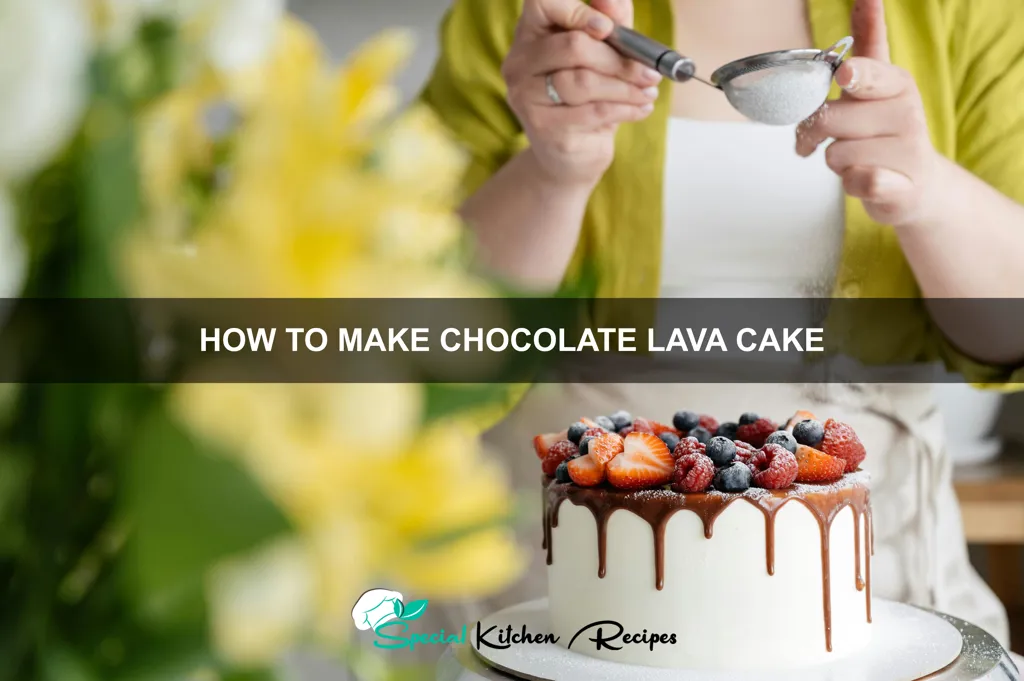Indulge in the decadent delight of the chocolate lava cake, a dessert that transcends mere confectionery and becomes a culinary experience. Its origins, while debated, are often linked to the late 20th century, with some attributing its rise to popularity to Jean-Georges Vongerichten, a renowned chef who popularized a molten chocolate cake in the 1980s. However, the concept of a cake with a warm, gooey center existed long before this, with hints of similar preparations in various cultures across the globe. What truly distinguishes the chocolate lava cake is its theatrical presentation: a seemingly solid exterior giving way to a molten chocolate heart, a surprise that delights both the eyes and the palate.
The lava cake’s rapid ascent to fame is remarkable. Its popularity exploded in the 1990s, becoming a staple on restaurant menus worldwide and inspiring countless variations. Though precise statistics on global lava cake consumption are difficult to obtain, its ubiquitous presence in high-end restaurants and home kitchens alike speaks volumes about its enduring appeal. The internet has further fueled its popularity, with countless recipes, videos, and enthusiastic online reviews readily available. This readily accessible information has democratized the dessert, allowing home bakers to recreate this luxurious treat with relative ease.
Beyond its deliciousness, the chocolate lava cake holds a certain cultural significance. It’s frequently associated with special occasions, romantic dinners, and celebrations. Its rich, intensely chocolatey flavor profile evokes feelings of indulgence and comfort, making it a perfect dessert for sharing or savoring in solitude. The carefully crafted contrast between the crisp exterior and the molten interior symbolizes a balance of textures and temperatures, reflecting a sophisticated culinary approach. The lava cake, therefore, is more than just a dessert; it’s a symbol of culinary artistry, a testament to the power of chocolate, and a delightful experience that continues to captivate food lovers worldwide.
Ingredients and Measurements
Creating the perfect chocolate lava cake hinges on precise measurements and high-quality ingredients. Don’t be tempted to substitute without understanding the impact on the final texture and taste. We’ll be using metric measurements for accuracy, but conversions are readily available online if needed.
Butter: 115g (1 stick plus 1 tablespoon) unsalted butter, softened to room temperature. Crucial Note: Using softened butter, not melted, is essential for proper emulsification with the sugar and eggs. If your butter is too cold, the batter will be lumpy. If it’s too warm, it will create a greasy texture.
Sugar: 170g granulated sugar. This provides the sweetness and helps create the cake’s rich, moist crumb. Avoid using powdered sugar as it contains cornstarch which will alter the texture.
Eggs: 2 large eggs, at room temperature. Room temperature eggs emulsify better with the other ingredients, resulting in a smoother batter. Cold eggs can lead to a grainy texture.
Vanilla Extract: 1 teaspoon pure vanilla extract. Use a high-quality vanilla extract for the best flavor. Artificial vanilla extract will noticeably alter the taste.
Flour: 70g all-purpose flour. Do not over-mix the batter once the flour is added, as this develops gluten and will result in a tough cake. Sift the flour beforehand for a lighter texture.
Cocoa Powder: 70g unsweetened cocoa powder. Use a high-quality Dutch-processed cocoa powder for a deep, rich chocolate flavor. Using regular cocoa powder will result in a slightly more acidic taste.
Salt: ¼ teaspoon fine sea salt. Salt enhances the chocolate flavor and balances the sweetness. Don’t skip this crucial ingredient!
Chocolate: 170g high-quality dark chocolate (70% cacao or higher), chopped finely. The quality of your chocolate significantly impacts the final taste. Use good quality chocolate for the best results. Finely chopping the chocolate ensures even melting.
Optional additions: For an extra touch of luxury, consider adding a pinch of espresso powder or a teaspoon of strong coffee to the batter. A splash of Grand Marnier or other orange liqueur can also add a delightful complexity.
Equipment Preparation
Before you begin crafting your decadent chocolate lava cakes, meticulous equipment preparation is key to achieving perfectly molten centers and flawlessly smooth exteriors. This section details the necessary tools and their preparation for optimal results.
First, you’ll need six 6-ounce ramekins. These should be oven-safe and preferably dark-colored to absorb heat evenly, ensuring consistent baking. Lightly grease each ramekin with butter – approximately 1 teaspoon total for all six – and then dust them with cocoa powder. This double-greasing technique prevents sticking and adds a rich chocolatey flavor to the final product. Tap out any excess cocoa powder to avoid a thick coating that might affect the cake’s texture.
Next, gather your mixing equipment. You’ll need two mixing bowls: one large (at least 3-quart capacity) for combining the wet ingredients and one medium-sized (approximately 1.5-quart capacity) for the dry ingredients. A whisk is essential for smoothly incorporating the dry and wet ingredients, preventing lumps and ensuring a consistent batter. Choose a sturdy whisk that can handle the slightly thick batter.
A rubber spatula or silicone scraper is invaluable for scraping down the sides of the bowls and ensuring all ingredients are fully incorporated. This is particularly crucial when combining the melted chocolate and butter, preventing any unmelted chocolate from remaining in the bowl. A high-quality spatula will make a significant difference in the final texture of your lava cakes.
For measuring ingredients accurately, you’ll require measuring cups and spoons. Using accurate measurements is paramount in baking; a kitchen scale is highly recommended for precision, especially when measuring the butter and chocolate. A measuring jug for liquids will be helpful for easily measuring the milk and eggs.
Finally, prepare your oven. Preheat your oven to 425°F (220°C). Ensure your oven temperature is accurate using an oven thermometer to guarantee even baking and perfectly set lava cakes. Having everything ready – the preheated oven, prepared ramekins, and measured ingredients – will streamline the baking process and allow you to focus on creating the perfect chocolate lava cakes.
Chocolate Preparation (Melting and Tempering)
The success of your chocolate lava cake hinges on the quality of your melted chocolate. We’ll be using high-quality dark chocolate, specifically 60% cacao or higher, for its rich flavor and melt properties. For this recipe, we’ll need 6 ounces (170g) of finely chopped dark chocolate. Using a good quality chocolate is crucial; cheaper brands often contain more stabilizers that can affect the final texture.
Begin by chopping the chocolate into small, roughly equal pieces. This will ensure even melting. Avoid using a microplane or grating the chocolate as this can introduce too much heat and lead to seizing. The smaller pieces create a larger surface area, facilitating quicker and more even melting.
There are several methods for melting chocolate, but the double boiler method is generally preferred for its gentle heat control. Place a heatproof bowl over a saucepan of simmering water, ensuring the bottom of the bowl doesn’t touch the water. This prevents direct heat from burning the chocolate. Add your chopped chocolate to the bowl. Stir gently and consistently, using a spatula or heatproof spoon, until the chocolate is completely smooth and melted. Avoid stirring vigorously, as this can incorporate air bubbles.
Now, let’s talk about tempering. Tempering chocolate is essential for achieving a glossy shine, a crisp snap, and a beautiful, stable finish on your lava cake. While not strictly necessary for a lava cake, tempering enhances the overall experience. For a simple tempering method, use the seeding method. Once the chocolate is completely melted, remove it from the heat and let it cool slightly to around 88-90°F (31-32°C). You can check this with a candy thermometer. Then, add 1-2 tablespoons of finely chopped, unmelted chocolate (seeds) to the melted chocolate. Stir gently until the seeds are fully incorporated and the temperature stabilizes. This process introduces stable chocolate crystals, leading to proper tempering.
Important note: If your chocolate seizes (becomes thick and grainy), it’s likely due to too much water or moisture. Don’t panic! Try adding a teaspoon of vegetable oil or shortening to the seized chocolate and gently stir until smooth. This should help restore its fluidity. Always ensure your equipment is completely dry before starting.
Once your chocolate is tempered (or simply melted if you choose to skip this step), it’s ready to be incorporated into your lava cake batter. Remember to work efficiently as the chocolate will begin to thicken as it cools.
Batter Preparation (Mixing Wet and Dry Ingredients)
This section details the crucial step of combining the wet and dry ingredients for your decadent chocolate lava cake. Precise measurements and careful technique are key to achieving that perfect molten chocolate center.
First, prepare your wet ingredients. In a medium-sized bowl, combine 4 large eggs and 1 cup (200g) granulated sugar. Using a hand mixer or stand mixer fitted with a whisk attachment, beat these ingredients together on medium-high speed for at least 3-4 minutes. This is crucial; the goal is to incorporate ample air into the mixture, resulting in a lighter, fluffier cake. The mixture should increase noticeably in volume and become pale yellow and creamy. Don’t rush this step!
Next, melt your chocolate. In a separate, heatproof bowl set over a pan of simmering water (a double boiler), gently melt 6 ounces (170g) of high-quality dark chocolate, chopped into small pieces. Stir occasionally until completely smooth and melted. Remove from heat and set aside to cool slightly. Avoid overheating the chocolate, as it can seize up and become grainy.
Now, carefully incorporate the melted chocolate into the egg and sugar mixture. Add it gradually, mixing on low speed to avoid curdling. Once fully incorporated, add 1/2 cup (60g) unsalted butter, melted and slightly cooled. Mix until fully combined and the batter is smooth and glossy.
In a separate bowl, whisk together your dry ingredients: 1/2 cup (60g) all-purpose flour, 1/4 cup (20g) unsweetened cocoa powder, and 1/4 teaspoon baking powder. Sift the dry ingredients together to ensure a smooth batter and to avoid lumps. Do not overmix the dry ingredients.
Gently fold the dry ingredients into the wet ingredients using a spatula. Use a gentle folding motion, rather than stirring, to avoid deflating the batter. Mix until just combined – a few small streaks of flour are acceptable; overmixing will result in a tough cake. Once combined, your batter should be thick and decadent.
Your batter is now ready to be portioned into your prepared ramekins. Proceed to the next section for baking instructions.
Cake Portioning and Baking
Precise portioning is crucial for achieving perfectly molten chocolate centers in your lava cakes. We recommend using ramekins, specifically 6-ounce ramekins, for optimal results. These ramekins provide the ideal size for a single serving, ensuring even cooking and a luscious, gooey interior. Do not use larger ramekins, as the cakes will take longer to bake and may not achieve the desired molten core. Smaller ramekins will result in overcooked cakes.
Before beginning, grease your ramekins generously. Use a neutral-flavored oil like canola or vegetable oil. This prevents sticking and ensures easy removal of the finished cakes. After greasing, lightly dust the ramekins with cocoa powder. This adds a subtle chocolate flavor and further aids in preventing sticking. You can also line the ramekins with paper baking cups for extra insurance, but ensure they are tall enough to contain the batter without overflowing.
Once your batter is prepared (following the recipe instructions), carefully divide it evenly amongst the prepared ramekins. Use a kitchen scale for the most accurate portioning. Aim for approximately 100-120 grams of batter per ramekin. This ensures consistent baking times and results. If you don’t have a scale, use a small ice cream scoop or a large spoon to divide the batter as evenly as possible, ensuring each ramekin is filled to about ¾ full. Overfilling will lead to messy spills and uneven cooking.
Place the filled ramekins onto a baking sheet. This provides stability during baking and makes it easier to transfer them to and from the oven. Baking time is crucial. It will vary depending on your oven, but generally, 12-15 minutes at 425°F (220°C) is the sweet spot. Start checking for doneness around the 12-minute mark. The edges should be set, and the center should still be slightly jiggly. Do not overbake! Overbaked lava cakes will be dry and lack the signature molten chocolate center.
To check for doneness, gently insert a toothpick or thin knife into the center of one cake. If it comes out with moist crumbs and a little bit of uncooked batter clinging to it, the cake is perfect. If it comes out clean, it’s likely overbaked. Let the cakes cool in the ramekins for a few minutes before carefully inverting them onto serving plates. Serve immediately for the best texture and flavor. Enjoy your decadent chocolate lava cakes!
Cooling and Setting
Once your molten chocolate lava cakes emerge from the oven, their delicate centers are still quite liquid. Proper cooling is crucial to achieving that perfect contrast between the gooey interior and the slightly firm exterior. Improper cooling can lead to a completely runny cake or, conversely, a dense, overcooked one. Therefore, this stage requires precision and patience.
Immediately after removing the ramekins from the oven, let them rest on a wire rack for at least 5-7 minutes. This initial cooling period allows the edges to firm up slightly, preventing the cakes from collapsing as they continue to cool. Avoid placing them directly on a cold surface, as this can cause thermal shock and cracking.
After the initial 5-7 minutes, carefully run a thin, offset spatula or a butter knife around the edges of each cake within the ramekin. This helps to release the cake from the sides, preventing sticking and making unmolding easier. A gentle rocking motion can also aid in this process. Be very careful; the cakes are still extremely hot and delicate at this stage.
To unmold the cakes, invert each ramekin onto a serving plate. The cake should slide out relatively easily thanks to the butter and the slight cooling. If it resists, gently tap the bottom of the ramekin until it releases. If some sticking persists, you can carefully run the spatula around the edges again.
Allow the cakes to cool further on the plates for another 5-10 minutes before serving. This allows the center to set just enough to be manageable without losing its desirable molten texture. The exact cooling time will depend on the size of your ramekins and your oven’s temperature, so observe carefully. Over-cooling will result in a less impressive lava effect, while under-cooling could lead to a messy, overly runny dessert.
Professional Tip: For a perfectly controlled cooling experience, consider using ramekins of consistent size and material (e.g., all ceramic ramekins of the same volume). This ensures even baking and cooling across all your lava cakes. Also, pre-chilling your ramekins slightly before baking can help to control the cooking process and achieve a more consistent result.
For optimal presentation, dust the cooled cakes lightly with powdered sugar or cocoa powder just before serving. A scoop of vanilla ice cream or a drizzle of fresh berry coulis complements the warm, rich chocolate beautifully.
Recommendations
For the best chocolate lava cake experience, we highly recommend using high-quality dark chocolate with a minimum of 70% cacao. The richer the chocolate, the more intense the flavor will be. Ensure your eggs are at room temperature for optimal emulsification, resulting in a smoother, more decadent texture. Don’t overbake! The cake should be slightly gooey in the center. A toothpick inserted into the center should come out with moist crumbs, not completely clean.
Serving Suggestions: This rich dessert is best served immediately after baking, allowing the warm, molten chocolate to flow. A scoop of vanilla bean ice cream or a dollop of whipped cream provides a delightful contrast in temperature and texture. A sprinkle of sea salt on top enhances the chocolate’s flavor. Consider adding fresh berries like raspberries or strawberries for a fruity counterpoint.
Storage: Leftovers (if any!) should be stored in an airtight container in the refrigerator for up to 2 days. Reheating is best done in the microwave for short bursts, or in a preheated oven at a low temperature (around 300°F/150°C) until warmed through. Avoid over-reheating, as this will dry out the cake.
Complementary Dishes: This decadent dessert pairs beautifully with a light and refreshing palate cleanser, such as a lemon sorbet or a simple green salad with a light vinaigrette. A strong espresso or a glass of dessert wine, like a tawny port or a late-harvest Riesling, can also complement the rich chocolate flavors.
Nutritional Information (Approximate per serving, based on a 6-serving recipe): Calories: 400-500, Fat: 25-30g, Saturated Fat: 15-20g, Cholesterol: 100-150mg, Sodium: 50-100mg, Carbohydrates: 40-50g, Sugar: 25-35g, Protein: 5-7g. Note: Nutritional information can vary depending on the specific ingredients used. This is an estimate and should be considered an approximation.
Enjoy your delicious homemade chocolate lava cakes!





